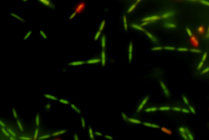Biomolecules identified at the nanoscale
New method for measuring amino acids
For the first time, a team of scientists has been able to identify individual amino acids in a peptide, a combination of several amino acids, on the surface of a single molecule. This means that one of the basic building blocks of life can now be studied down to the nanometre level. Led by Professor Uta Schlickum from Technische Universität Braunschweig, the group in the QuantumFrontiers Cluster of Excellence developed a new measurement method, which they have published in the journal Nature Communications.
The distinction between peptide and protein seems somewhat arbitrary and depends solely on size: as long as no more than about 100 amino acids form a chain, it is a peptide. As soon as there are more, biology refers to them as proteins. Peptides occur in all kinds of biological processes. For example, as hormones or antibiotics. However, research into exactly how peptides work is still in its infancy. This is partly because no microscope is able to see the biological components of individual peptides down to the atomic level.
The research team led by Professor Uta Schlickum has combined different methods to make a scanning tunnelling microscope useful for peptide recognition. Although these microscopes are accurate down to the atomic level, they are unable to distinguish between different elements of a molecular structure. A collaboration between TU Braunschweig, the Max Planck Institute for Solid State Research in Stuttgart and other international scientists has now succeeded in making the measuring tip of the imaging device chemically sensitive and specialised to one of the amino acids in the peptide. This novel tip makes it possible for the first time to visualise and identify individual amino acids in complex biological chains under the microscope. This is a first step towards sequencing peptides on surfaces with the highest spatial resolution.
Original publication
Xu Wu, Bogdana Borca, Suman Sen, Sebastian Koslowski, Sabine Abb, Daniel Pablo Rosenblatt, Aurelio Gallardo, Jesús I. Mendieta-Moreno, Matyas Nachtigall, Pavel Jelinek, Stephan Rauschenbach, Klaus Kern, Uta Schlickum; "Molecular sensitised probe for amino acid recognition within peptide sequences"; Nature Communications, Volume 14, 2023-12-14
Most read news
Original publication
Xu Wu, Bogdana Borca, Suman Sen, Sebastian Koslowski, Sabine Abb, Daniel Pablo Rosenblatt, Aurelio Gallardo, Jesús I. Mendieta-Moreno, Matyas Nachtigall, Pavel Jelinek, Stephan Rauschenbach, Klaus Kern, Uta Schlickum; "Molecular sensitised probe for amino acid recognition within peptide sequences"; Nature Communications, Volume 14, 2023-12-14
Topics
Organizations
Other news from the department science

Get the life science industry in your inbox
By submitting this form you agree that LUMITOS AG will send you the newsletter(s) selected above by email. Your data will not be passed on to third parties. Your data will be stored and processed in accordance with our data protection regulations. LUMITOS may contact you by email for the purpose of advertising or market and opinion surveys. You can revoke your consent at any time without giving reasons to LUMITOS AG, Ernst-Augustin-Str. 2, 12489 Berlin, Germany or by e-mail at revoke@lumitos.com with effect for the future. In addition, each email contains a link to unsubscribe from the corresponding newsletter.
Most read news
More news from our other portals
Last viewed contents
NiKem Research and Chiesi Farmaceutici Extend Research Collaboration

Rentschler Biopharma breaks ground at new U.S. production site in greater Boston - Multi-product facility to focus on commercial production of complex molecules for U.S.-based clients
BASF plans significant investment in ibuprofen capacities in Germany and North America - New world-scale ibuprofen production plant in Ludwigshafen
Going back to nature - A look at processing systems for white biotech applications























































